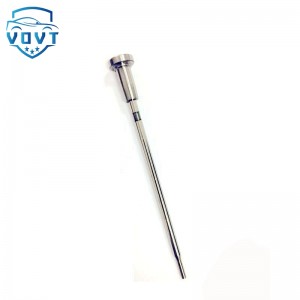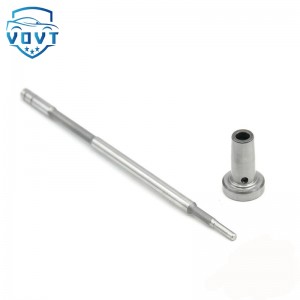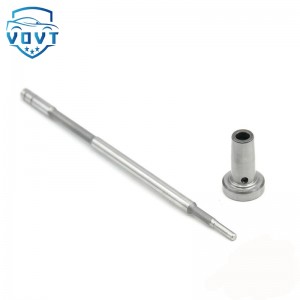Common Rail Control Valve 9308Z625C 9308-625C Fuel Injector Valve Diesel Injector Control Valve
Products Description
| Reference Codes |
9308Z625C |
| Application | 9308Z625C |
| MOQ | 6PCS |
| Certification | ISO9001 |
| Place of Origin | China |
| Packaging | Neutral packing |
| Quality Control | 100% tested before shipment |
| Lead time | 7~10 working days |
| Payment | T/T, L/C, Paypal, Western Union, MoneyGram or as your requirement |
Injector control valve
Structural composition
Valve body: usually the outer shell of the injector control valve, with various channels and chambers inside to guide the flow of fuel. For example, a valve body of an injector control valve is provided with a guide groove inside, a fuel nozzle is provided at one end, and the other end is closed, and there are also oil inlet and oil outlet.
Needle valve: slidingly set in the guide groove of the valve body, one end is inserted into the fuel nozzle, and the other end is provided with a guide block. The movement of the needle valve controls the opening and closing of the fuel nozzle, thereby controlling the injection of fuel.
Sliding block: also slidingly set in the guide groove, with a first spring provided between the guide block. A through hole is opened on the sliding block, and a groove is provided on the contact surface with the valve body. A first channel is provided between the groove and the through hole, which is used to allow oil to enter the groove to lubricate the inner wall of the valve body and reduce the wear of the sliding block.
Electromagnetic coil: In some electronically controlled injector control valves, the electromagnetic coil is used to receive signals from the electronic control unit (ECU). When the electromagnetic coil is energized, a magnetic field is generated, and the movement of the needle valve or other related components is controlled by magnetic force, thereby realizing the control of fuel injection.
Working principle
Take the common electronic fuel injector control valve as an example. When the fuel injection command is not received, the electromagnetic coil is not energized, and the needle valve is in the closed position under the action of spring force, etc., preventing the fuel from flowing from the fuel inlet to the fuel injector. When the ECU issues a fuel injection command, the current passes through the electromagnetic coil to generate a magnetic field. The magnetic field force overcomes the spring force, etc., causing the needle valve to move upward, opening the fuel injection channel, and the fuel enters from the fuel inlet and is ejected through the fuel injector. The ECU controls the opening time and frequency of the electromagnetic coil, accurately controls the opening time and number of the needle valve, and then accurately controls the fuel injection amount and timing to meet the fuel requirements of the engine under different working conditions.
Function
Precisely control the fuel injection amount: According to the engine load, speed and other working conditions, receive the ECU's instructions, accurately control the amount of fuel injected by the injector each time, and ensure that the engine can obtain a suitable air-fuel ratio under various conditions to achieve good power performance, fuel economy and emission performance.
Control the timing of fuel injection: accurately control the start time and duration of fuel injection, so that the fuel is injected into the combustion chamber at the best time in the different strokes of the engine, such as intake, compression, and power, to ensure that the fuel and air are fully mixed and effectively burned, and improve the efficiency and performance of the engine.
Common faults and causes
Solenoid valve failure: The electromagnetic coil may be damaged due to long-term use, overheating, short circuit, etc., resulting in the inability to generate a magnetic field to control the movement of the needle valve normally. For example, the insulation layer of the electromagnetic coil is aged and damaged, which may cause a short circuit and make the solenoid valve unable to work.
Needle valve stuck: impurities, carbon deposits, etc. in the fuel may enter the control valve, hindering the normal sliding of the needle valve, making it unable to open and close flexibly. Or the matching clearance between the needle valve and the valve seat becomes larger due to wear and other reasons, resulting in fuel leakage and affecting the injection accuracy.
Damage to seals: Seals in the control valve, such as O-rings, sealing rings, etc., may age, deform or be damaged after long-term use, resulting in fuel leakage. Fuel leakage not only affects the injection effect, but also may cause fuel waste and environmental pollution.
Maintenance and care
Use clean fuel: Ensure the use of high-quality, clean fuel to avoid impurities, water, etc. in the fuel from entering the injector control valve. The possibility of impurities entering can be reduced by regularly replacing the fuel filter.
Regular inspection: When regularly maintaining the engine, check the working status of the injector control valve to see if there are abnormal conditions such as fuel leakage and uneven fuel injection. You can use professional diagnostic equipment to detect the resistance of the solenoid valve, injection pulse signal, etc. to determine whether the control valve is working properly.
Avoid long-term idling or low-speed operation of the engine: Long-term idling or low-speed operation can easily lead to incomplete fuel combustion and carbon deposits, which may affect the normal operation of the injector control valve. Properly running the engine under different working conditions will help keep the injector control valve clean and in good performance.





























